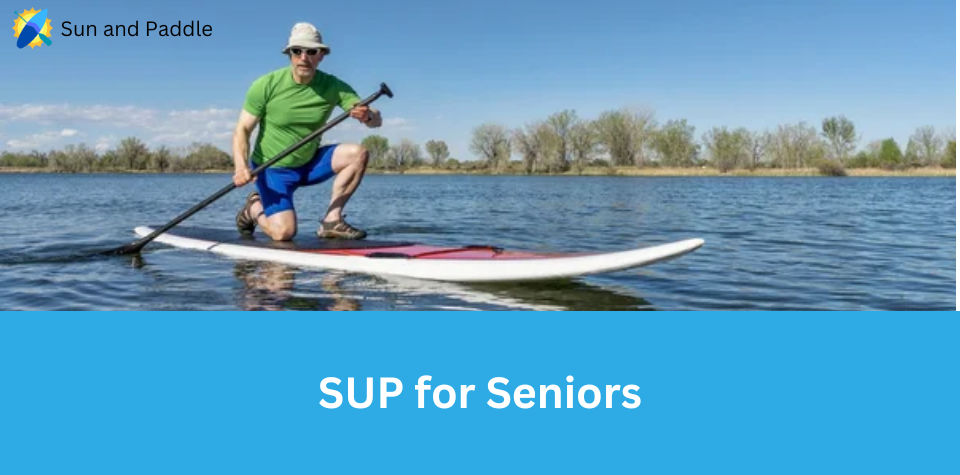Paddleboarding has emerged as a popular and engaging way for individuals of all ages to enjoy water sports, and it’s gaining particular acclaim among seniors looking for a fun, low-impact activity. This sport offers seniors the chance to enhance their balance, improve cardiovascular health, and explore nature from the unique perspective of standing on water. While it may seem daunting at first, paddleboarding can be quite accessible with the proper equipment and techniques.
For seniors interested in paddleboarding, it is important to begin at a comfortable pace and opt for wider boards that provide better stability. Many find the calm, flat waters of a lake or a quiet beach ideal for their first few outings. In addition to the physical benefits, paddleboarding also presents an opportunity for social interaction and mental relaxation, as it often takes place in serene environments that promote mindfulness and an appreciation for the outdoors.
Key Takeaways
- Paddleboarding is a low-impact activity that can improve balance and cardiovascular health.
- Seniors should start with stable boards and calm environments when learning to paddleboard.
- Consulting with a healthcare provider is advised before starting paddleboarding to ensure it aligns with individual health conditions.
Benefits of Paddleboarding for Seniors
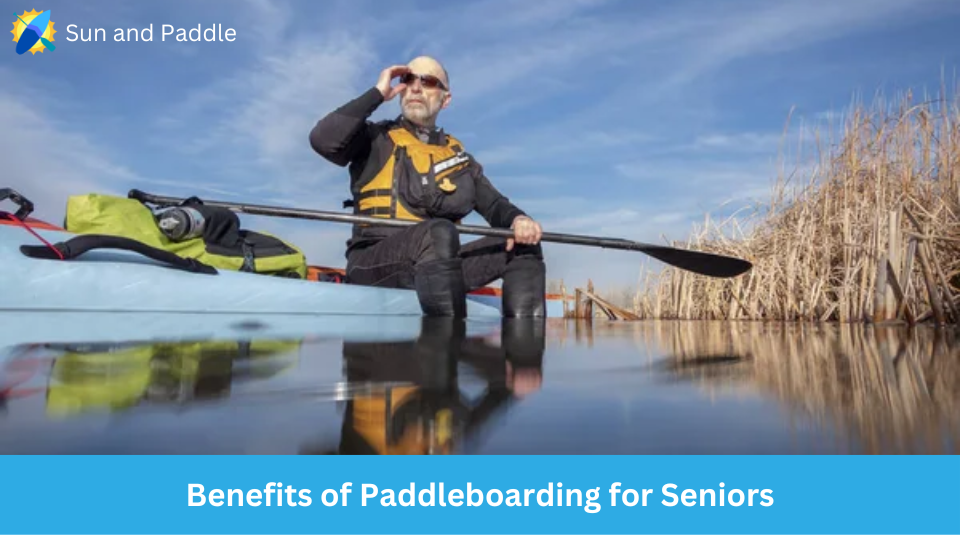
Paddleboarding offers numerous advantages for seniors, ranging from physical fitness to mental well-being, all while being a low-impact and accessible activity.
Fitness
When you engage in paddleboarding, you are involved in a full-body workout. Paddling works your upper body, while maintaining balance activates your core muscles. This activity can enhance your endurance and strength over time.
Improves Balance and Coordination
The very act of standing on a paddleboard requires balance, which, in turn, improves your proprioception. Regular practice on the board can lead to better coordination and stability in your daily activities.
Mental Health Benefits
Being out on the water can be incredibly soothing. Paddleboarding reduces stress by promoting the release of endorphins, the brain’s feel-good neurotransmitters. The tranquil environment helps clear your mind and improve mental clarity.
Social Activity
Paddleboarding doesn’t have to be a solitary activity. You can join clubs or groups, which allows for social interactions. Building friendships and sharing experiences are integral parts of paddleboarding.
Accessible
Paddleboarding is a sport with a relatively easy learning curve, making it accessible to people of all ages. With the appropriate safety measures like a life jacket, you can paddle at your own pace.
Low-Impact Exercise
This sport is gentle on the joints, as it’s a low-impact exercise. You can enjoy physical activity without the risk of high-impact injuries, preserving your joint health and mobility.
Exposure to Sun & Vitamin-D
Paddleboarding outdoors allows you to soak in the sun, providing a natural source of Vitamin D. This is essential for maintaining strong bones and a healthy immune system. Just remember to apply sunscreen to protect your skin from excessive UV exposure.
Tips for Seniors Paddleboarding

To ensure safety and enjoyment while paddleboarding, it is essential for seniors to consider their physical capabilities and environmental conditions. The following tips provide guidance on equipment, techniques, and safety precautions tailored for senior paddleboarders.
Begin in Calm, Flat Water
Choose a body of water that is calm and flat for your first few paddleboarding experiences. This will help you maintain your balance and learn the basic paddling techniques with less risk of falling in.
Use a Properly Sized Paddle
Ensure your paddle is the right length. A general rule is that the paddle should be about 6 to 10 inches taller than you when standing it upright on the ground.
Stand with Your Feet Shoulder-Width Apart
Once you’re up, your feet should be parallel, about shoulder-width apart, and centered between the rails (sides) of the board for the best stability.
Start in a Kneeling Position
Begin paddling on your knees and slowly stand up, one foot at a time, once you feel stable. This helps you get a feel for the board’s balance.
Check the Wind
Before setting out, take note of the wind’s strength and direction. Strong winds can make paddling back difficult, so plan accordingly to avoid exhaustion.
Use a Leash
Always wear a leash that connects you to your paddleboard. In case you fall off, the board will stay close to you, acting as a large flotation device.
Monitor the Swells
Watch for changes in water conditions and be aware of swells. If they’re too strong, they could affect your balance and paddling ability.
Paddleboard with a Partner or Group
Paddling with someone else not only makes for a more enjoyable experience but also ensures that there’s help available if you need it.
Learn to Swim
If you’re not already a swimmer, consider taking lessons. It’s a vital safety skill for any water sport.
Wear a Personal Floatation Device
A personal floatation device (PFD) should be worn at all times. Certain areas have specific laws about PFDs, so make sure to follow local regulations.
Bring a Whistle
Carry a whistle with you to signal for help if needed. Attach it to your PFD for easy access.
Make Sure Someone Knows You are Going Out
Before leaving, inform someone onshore of your plans and predicted return time.
Wear a Wetsuit
Wearing a wetsuit can provide thermal protection and buoyancy if you’re paddleboarding in cooler waters.
Stay Close to Shore in Water 4-5 Feet Deep
Especially when starting out, stay close to the shore and in water that is no deeper than 4-5 feet, allowing you to regain your footing if you fall.
Use Sunscreen or Sunblocking Clothes
Protect your skin from the sun by applying sunscreen or wearing sunblocking clothes, as UV radiation is stronger on the water.
Wear Water Shoes
Water shoes can protect your feet from sharp objects in the water and add grip on your paddleboard.
Paddleboard Early in the Morning
The water is generally calmest in the early morning, making it an ideal time for paddleboarding.
Go at Your Own Pace
Don’t feel pressured to keep up with others. Paddle at a pace that feels comfortable for you and take breaks as needed.
These are just some of the tips for paddleboarding as a Senior. Here is an article on how to paddleboard that covers the movements more detail.
Check with Your Doctor Before Paddleboarding if:
You Plan to Paddleboard for Rehabilitative Reasons
If you’re considering paddleboarding as part of a rehabilitation program, it’s essential to discuss this with your doctor to ensure it aligns with your recovery plan. Paddleboarding can offer gentle exercise, but only if it’s appropriate for your rehabilitation stage.
You Have Heart Disease
Engage in conversation with your medical advisor if you have a heart condition. The exertion involved in paddleboarding could impact your heart, requiring medical clearance to ensure safety.
You Have Type 2 Diabetes
Should you have Type 2 diabetes, monitoring your blood sugar levels during physical activities like paddleboarding is vital. Ask your doctor for specific guidelines on how to manage your diabetes while on the water.
You Have High Blood Pressure
Patients with high blood pressure need to take precautions. Physical exertion, including paddling, can affect blood pressure levels. Your doctor can provide advice on monitoring and managing your condition during such activities.
You Have Arthritis
Arthritis sufferers should discuss how paddleboarding might affect their joints. Your healthcare provider can suggest modifications or determine if paddleboarding is a suitable exercise for you.
You Have Just Finished Cancer Treatment
Post-cancer treatment, your body may require different kinds of care. Check with your healthcare team to assess if paddleboarding is a safe and beneficial form of physical activity for you at this time.
You Are Not Usually Active
If you’re new to regular exercise, a healthcare assessment is advisable before starting any new physical routines, including paddleboarding. This will help ensure the activity does not pose any health risks.
You Just Want to Be Cautious and Ask for Advice Beforehand
Even if you’re in good health, getting a professional’s opinion can never hurt. Asking for advice can help you better understand the precautions needed to paddleboard safely.
Best Paddleboards for Seniors
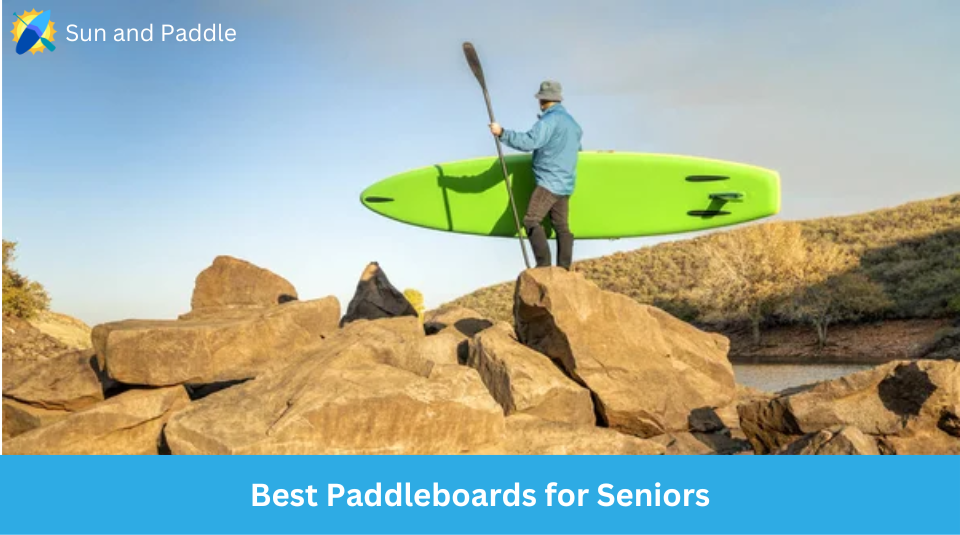
Paddleboarding is one of the top senior activities. Not only is it enjoyable, but it also has numerous health benefits. And it is so simple to master. Paddleboarding doesn’t require extreme athleticism. Everyone can easily learn how to paddleboard. Because different types of paddleboards are used for various purposes, you must be aware of them. But as a senior, there are a few additional characteristics a paddleboard must possess.
You need a paddle board that is more stable than average if you are a senior because your ability to maintain equilibrium diminishes with age. Additionally, because muscle mass and strength diminish with age, you need a lightweight board and paddle to make pedaling easier. Easily gliding through the water makes the experience more enjoyable. And you likely desire a board that is adaptable and travel-friendly, as your retirement is filled with a variety of excursions and celebrations. For instance, to paddle down the river close to your home, capture a few waves, relax in the sun, kayak, and paddle board with your grandchildren, friends, and family, etc.
You want a paddleboard that matches your capabilities, weight, height, and intended use when shopping for one. Before purchasing a paddleboard, it is necessary to consider these factors, as paddleboards come in a variety of sizes and shapes and serve a variety of purposes. Here is why…
Paddleboards appear in various sizes because each individual is unique. There is no universally sized paddle board. A taller individual requires a longer, wider, and sometimes denser board to achieve the same level of comfort and stability as a shorter individual on a shorter board. Additionally, if you plan to paddle alone, you need a different size board than if you plan to canoe with a partner or your grandchildren.
Paddleboard performance is influenced by the design of the board. When searching for a paddle board for long-distance excursions, you need a lengthier and narrower touring paddle board. With a touring paddle board, speed takes precedence over stability. Then there is the activity paddle board, which has a rounded nose and is wider and bulkier for increased stability. This board is utilized specifically for yoga and water-based exercises. Activity paddleboards are more difficult to maneuver in terms of speed and turns compared to touring paddleboards.
Then there is the all-around paddle board, which provides the optimal balance of speed and stability and is ideal for multiple uses. These boards have an oval-shaped snout for superior speed performance, but are wider than touring boards to provide comfort and stability for an effortless and enjoyable ride. With mounting points, a padded kayak seat, and an additional paddle piece for kayak paddling, the majority of all-purpose paddle boards can be converted into kayaks.
Five Best Paddleboards for Seniors
1. Nautical 10’6’/11’6′ by iROCKER
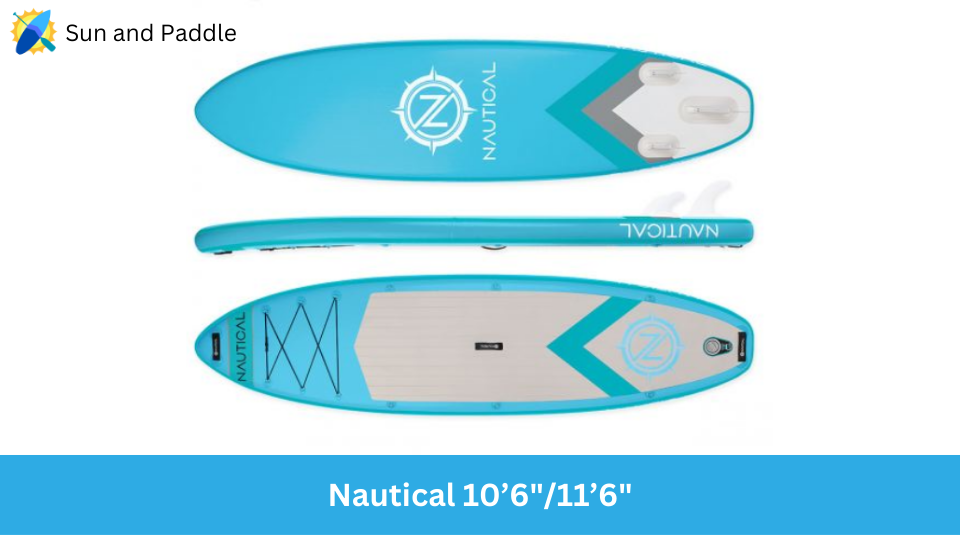
Whether a senior selects the 10’6 or 11’6 by iROCKER, both boards are well-made and feature a dual-layer pvc construction. This board also has a 32″ width and a 6″ thickness, making it more durable and stable for novice paddlers. The 10’6 board is more of an all-around board with an affordable price. However, the 11’6’s weight capacity is greater, allowing you to bring more supplies or a companion.
Both the Nautical 10’6 and 11’6 have a total of 17 d-rings, allowing elderly to customize their board with a kayak seat or additional storage space. Additionally, the Nautical features two 6-point bungee cargo areas, one at the nose and the other at the rear. The board also features a snap-lock technology on all three fins. In addition, each board is easy to transport; the 10’6 is 20 pounds and the 11’6 is 22 pounds. Prices begin at $349, which is reasonable.
2. Bluefin Cruise 10’8″
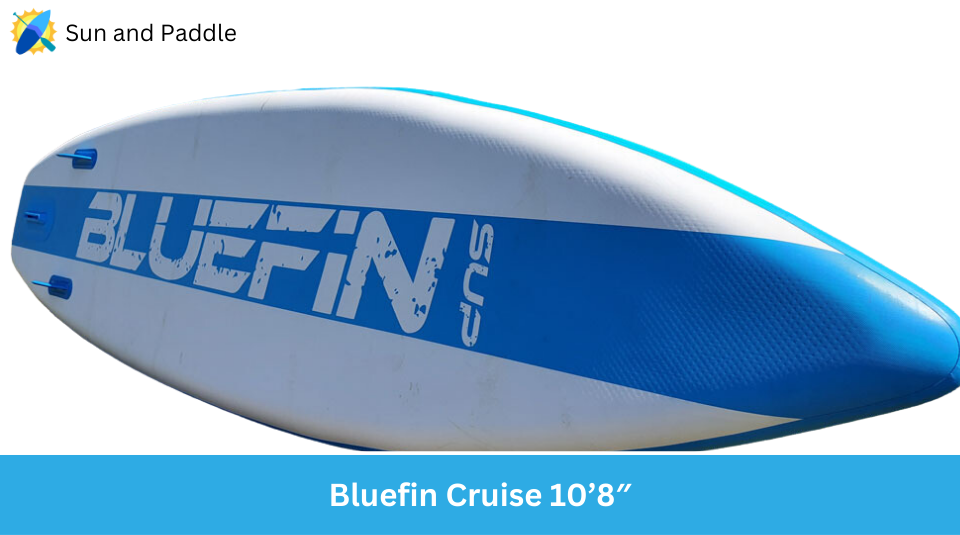
This offers a combined all-around and touring board measuring 10’8″ in length, 32″ in width, and 6.3″ in thickness. An affordable SUP with excellent balance, stability, and speed. It has a weight capacity of 330 pounds, making it ideal for carrying additional gear, a pet, or a guest. This board is well-made, but not particularly lightweight. With a triple layer of PVC, the coating is UV-resistant.
Additionally, the Bluefin Cruise has a dual-chamber inflation system. Bluefin maximizes durability by integrating a removable, snap-lock fin box. The Bluefin Cruise 10’8″ makes a statement by virtue of its superior construction and adaptability. The SUB board comes with a 5-year warranty and a 60-day money-back guarantee. Additionally, Bluefin Cruise offers a 12′ and a 15′ board for a slightly higher price. The Bluefin Cruise 10’8 begins at approximately $449.
3. Outdoor Master Ace 11’
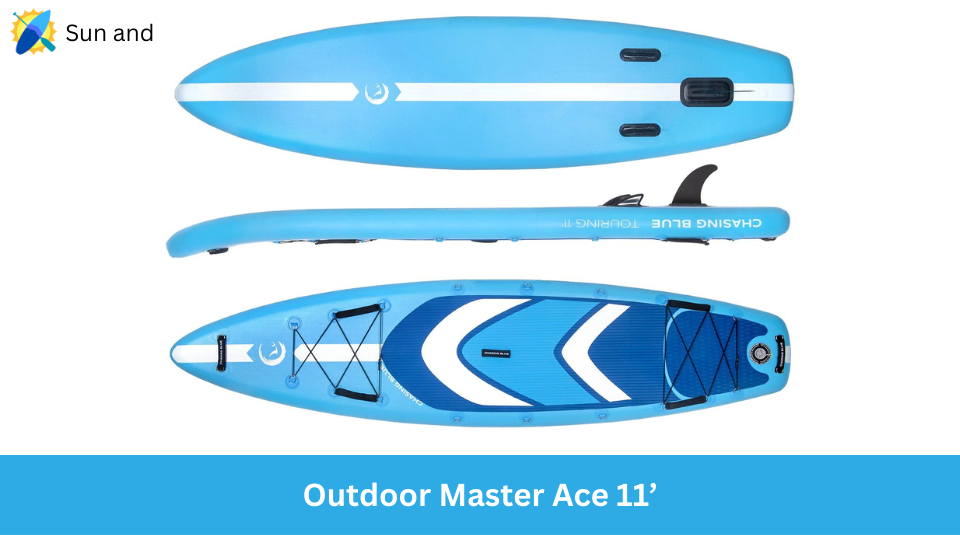
Outdoor Master provides an assortment of reasonably-priced SUP boards for novice and advanced riders. One of their finest boards is the Ace 11′ Sport iSUP. It is between an all-around and a touring board in terms of pace and stability. The board is 11′ long, 32″ wide, and 6″ thick. It can support up to 300 pounds and weighs only 23 pounds when carried. It also provides ample capacity for additional gear or a small passenger.
The Outdoor Master Ace features a detachable center snap-lock fin, dual pvc layer technology, 18 D-rings, and two pairs of safety handles to secure your gear or passenger. The board comes with a variety of accouterments, including a repair kit, waterproof phone case, and three-piece aluminum paddle. The Outdoor Master Ace 11′ retails for approximately $600, which is a bit more than the average SUP board.
4. Gili Mako 10’
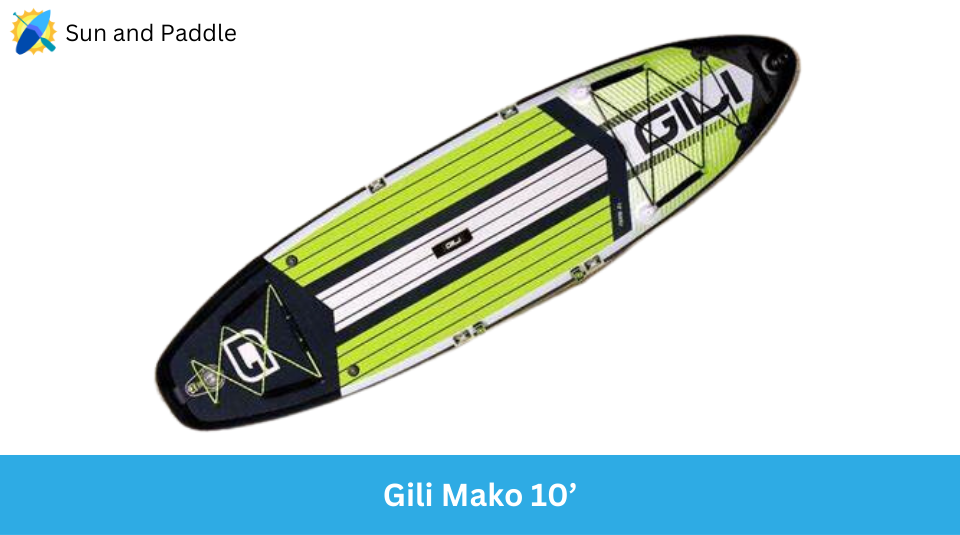
The Gili Air 10’6 and 11’6 are two of the finest paddleboards available. The Gili Mako, like the Nautical, features all-around rounded boards and provides stability with an additional inch of breadth. The Gili Mako can accommodate larger individuals or those who require additional supplies for their time on the water. The weight capacity of Gili boards is approximately 295 lbs. What makes the Gili boards so unique is their lightweight, single-layer PVC construction and extreme durability.
Additionally, the Gili has snap-lock fins, which are more durable than flexi fins and allow for improved navigation and maneuverability on the water. The board also has an abundance of features. 14 D-rings, a 6-point bungee cargo area at the nose, a 4-point bungee cargo area at the rear, and kayak seat attachments are included on Gili Mako boards. Additionally, the board has three carrying handles and a paddle receptacle. The Gili Mako 10′ is available for $559.
5. Thurso Surf 120 Waterwalker
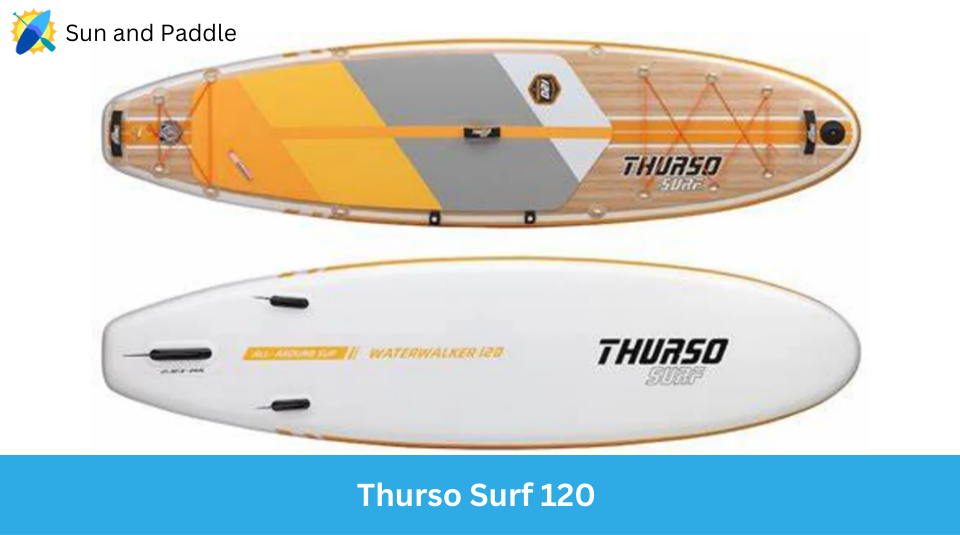
The Thurso Surf 120 Waterwalker is by far the most expensive stand-up paddleboard on this list; however, it is loaded with features and offers excellent value for the price. It has a length of 10 feet, a width of 30 inches, and a thickness of 6 inches, making it one of the swiftest and most maneuverable paddleboards on the list. The Thurso Surf 120 has a 260-pound weight capacity and a durable dual-layer construction with carbon rails for increased rigidity. In addition, the board has a 2+1 entirely removable snap-lock fin configuration, giving it exceptional performance on the water.
Front and rear bungee cargo areas, an additional paddle holder, an EVA deck pad, and four additional D-rings for additional gear stowage or a kayak seat are included. Those who select this board will also receive a double-chamber, triple-action pump, three snap-lock fins, a 10-foot coil leash, a roller SUP case, and a carbon paddle. The Thurso Surf 120 normally costs approximately $749, but it is presently on sale for $599.
FAQs
Can I participate in stand-up paddleboarding (SUP)?
One of the most frequent inquiries. Most individuals can do it, and they enjoy it! The majority of students master the fundamentals on the first day of study. Still somewhat of a secret, all ages and skill levels are welcome. Read the home page’s introduction before deciding if stand up paddle boarding is for you.
How long does it take to master SUP?
It is common for first-time paddlers to be able to stand and paddle within 20 minutes. This sport attracts a broad range of ages, from very young (children) to very old (seniors), and a wide range of skill levels, from beginner to seasoned athlete.
What is the importance of trying before buying?
As with any investment, you should ensure that SUP is a good fit for you. Find a retailer that offers demonstrations and tests out various boards. Try a friend’s board as well. If a rental includes instructions, that is a plus. A knowledgeable salesperson can be of assistance, but you will be on the board! Research online reviews and other information before making a purchase.
How do I locate the most suitable stand-up paddle board for my needs?
Consider how you intend to utilize your board, and be sure to ask a lot of questions at the SUP establishment. Check out “Picking the Ideal Stand-Up Paddleboard for You.” This section discusses board shapes, styles, quality, construction, etc., as well as hard boards versus inflatable boards and board measurements relative to your weight—an essential consideration when selecting a board.
Why does an individual’s weight matter?
You need a board that keeps you above the water to maximize your paddling efficacy. The heavier individual will cause the board to rest lower in the water when using the same surfboard as a lighter individual. This creates greater resistance, necessitating increased paddling effort. When it comes to how to choose a paddleboard, there is more to consider than just weight. For example, height and skill also matter.
Should I buy a hard or inflatable board?
This is a personal preference. Typically, inflatables are more durable, more stable, and require less storage space, but they are also less rigid (although some manufacturers are striving to improve this). Hard boards may be more practical, aesthetically attractive, and capable of a greater variety of tasks.
What does an SUP cost?
Boards range in price from approximately $600 – for the casual beginner paddler – to $5,000 (and possibly more for custom construction) for high-end boards designed for racing and the like. Consider the $1,000 to $2,000 price range if you’re looking for a durable board that will last with appropriate maintenance.
Is it accurate that the paddle is more essential than the board?
By selecting the ideal paddle for your requirements, you can avoid stress, fatigue, and injury. If you’re on a leisurely cruise, the choice of paddle may be based on price, but if you’re paddling long distances, a carbon fiber paddle will help you paddle longer by reducing fatigue. A quality paddle enhances the experience.
Should I use a life vest or PFD?
Most nations and/or regions have regulations regarding personal flotation devices (SUP PFDs) that are intended to protect individuals. For minors, a PFD should be worn without hesitation. Use a PFD if you cannot swim or if you are paddling in hazardous water. Always err on the side of caution: when in doubt, don a personal flotation device (PFD).
What should I wear to SUP?
Wear whatever is most convenient! Clothing that permits movement is optimal. Once you have mastered stand up paddling, you will not tumble into the water unless you are attempting to learn something new. There is clothing designed for water activities, but it is not required unless you are paddling in extreme weather conditions (downwinders) or paddling in challenging water conditions. On a warm day, you might wear only shorts, a T-shirt, and a rash guard, or long trousers and a jacket.
How can I teach a child to SUP?
Introducing kids to stand-up paddleboarding should be a step-by-step process, starting with familiarizing them with the board both on land and in shallow water. Young kids can be seated on the board while an adult stands next to them for comfort and safety. As they gain confidence, an adult can kneel on the SUP and paddle with the child seated in front. It’s crucial for the adult to be well-practiced in the sport before involving children to ensure their safety and ability to guide them. Initial practice should be conducted on land, with the board on soft grass to simulate the new sensation. When transitioning to water, begin in calm, shallow areas, ensuring the child’s safety and confidence in the water. Teach children paddling techniques and safety tips, such as falling safely to the side and remounting the board. Using a wide, stable board and starting with the child in a kneeling position can facilitate the learning process. The child can gradually attempt to stand and master more advanced techniques as they become more comfortable. There are specific boards for SUP for kids. Safety measures, including the use of personal flotation devices and leashes, are of utmost importance throughout this process.
What are the health benefits of paddleboarding for older adults?
Paddleboarding engages your core, improves cardiovascular health, and enhances joint flexibility. The low-impact nature of the sport makes it suitable for maintaining fitness in your golden years.
Are there any specific safety precautions seniors should consider when paddleboarding?
You should wear a personal floatation device at all times and consider paddleboarding with a buddy. Additionally, it’s advisable to check with a healthcare provider before beginning a new exercise regimen.
What is the recommended paddleboard type for seniors with limited mobility?
A wider and more stable paddleboard is often recommended for seniors, particularly those with limited mobility. An inflatable board can also be easier to transport and handle.
How can older beginners learn to paddleboard safely and effectively?
Beginners should start with lessons from a certified instructor to learn proper techniques and safety procedures. Calm, shallow waters are preferred for the initial learning process.
What techniques can seniors use to maintain balance while paddleboarding?
Focus on keeping your knees slightly bent, your core engaged, and your gaze fixed on the horizon. Practicing yoga or balance exercises on land can also greatly benefit your paddleboarding stability.
Is there an ideal paddleboarding environment for senior participants?
Seniors may find calm, flat waters, such as lakes or quiet coastal bays, most conducive to paddleboarding. It’s important to avoid areas with heavy boat traffic, strong currents, or large waves.

